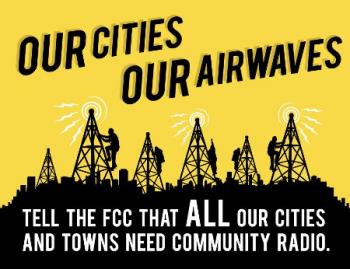Country to FCC: "Yes" to more community radio!

When the FCC asked the public to comment on a plan to reserve channels for low power radio in urban areas, the response was loud and clear: We need more community radio, in all of our cities and towns.
28 House Representatives wrote the FCC in support of more low power FM (LPFM) radio. This followed a letter from the four lead cosponsors of the Local Community Radio Act in both the House and Senate.
Next, nearly 1,700 letters were submitted to Congress and the FCC through an e-action coordinated by the Media and Democracy Coalition asking for more community radio. And a coalition of 16 national and 21 local media justice and media reform organizations wrote the FCC in support of a proposal from Prometheus to strengthen the FCC’s plan.
Prometheus supports the FCC’s plan to preserve channels for community radio, but we don’t think it goes far enough to ensure that these channels are in places with enough population to use them. (Get caught up on the details of the FCC’s original plan here.)
Reviewing the FCC’s plan with fellow low power radio advocates at REC Networks and Common Frequency, we found that the area in which the FCC searched for available frequencies was far too large in most markets, covering vast areas without much population. The FCC searched for available channels in the “center” of each market, but they defined the “center” as an area about 23-30 miles across (depending on the distance from the equator, as the FCC used a grid of 31x31 minutes, not miles). In many markets, this is way too large to assess whether frequencies will be available in populated areas.
For example, the FCC claims there are 12 frequencies in Tucson, but many of those channels are in deserts far outside the city, where few would listen to a station and even fewer might want to apply for one.
To improve on the FCC’s original plan, Prometheus, REC Networks, and Common Frequency submitted a joint proposal asking that the FCC use a grid of 21x21 minutes instead of the 31x31 minute grid. This would better assess whether channels are available in places with enough population to use them.
Winning channels for community radio in urban areas has always been an uphill battle, and it didn’t end when we passed the Local Community Radio Act. But that historic victory turned the tide, and the FCC’s proposed rules are the beginning of the end.
After the FCC reviews the comments and replies submitted this month, they will issue final rules sometime in the next few months, and then release a second rulemaking with more proposed changes to improve low power radio.
To create (in the FCC’s own words) “a robust, dynamic, and permanent LPFM service in larger markets,” we need to continue the fight until we win rules that allow every community a voice on the air. These are our cities, and our airwaves!
